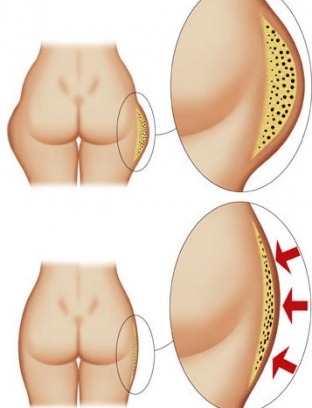A lot of techniques available in aesthetic medicine can be offered today for body shaping. One of them is mesotherapy with the use of drugs with a strong lipolytic effect. One of these drugs, long used to correct fat deposits in problem areas, is phosphatidylcholine. It allows for fat burning with impressive results, but requires the beautician to carefully follow the protocol for its use. Read about the features of chemical liposuction at estet-portal.com.
What makes mesotherapy effective in burning fat in problem areas
Chemical liposuction with the injection of lipolytic drugs into problem areas gives an excellent effect, not inferior to the surgical correction of fat deposits.
Most often, mesotherapy is offered for burning fat in hormonally dependent areas and places with genetically determined fat accumulations.
A good result is shown by chemical liposuction in the "breeches" zone and the back of the thigh, in the area of the so-called climacteric hump at the level of the 7th cervical vertebra. In addition, mesotherapy with lipolytics is recommended after surgical liposuction in order to correct the consequences of unevenly removed fatty tissue.
One of the drugs used for chemical liposuction is phosphatidylcholine. Its effectiveness is based on the fact that it is able to increase the sensitivity of fat cell receptors to stimulating effects, due to which lipolysis processes are accelerated in these cells, and metabolic processes are improved. Previously, it was used for the treatment of xanthelasma - fatty formation on the eyelid, and then the area of \u200b\u200buse of this lipolytic has expanded significantly. He is capable of:
- accelerate tissue regeneration,
- slow down the development of fibrosis,
- improve dermal retraction,
- reduce the progression of cellulite.
However, the use of phosphatidylcholine in mesotherapeutic techniques requires careful collection of the patient's history and adherence to the protocol of the procedure. So, if the patient is allergic to soy, the drug is absolutely contraindicated, since soybeans are a source of medical phosphatidylcholine production. Contraindications for burning fat with this drug will be liver and kidney diseases, pregnancy and lactation, collagenoses and uncompensated diabetes, exacerbated infectious and somatic diseases.
Peculiarities of fat burning procedure using phosphatidylcholine
Almost all the complications that were observed after mesotherapy with phosphatidylcholine are due to the negligence of the cosmetologist during the procedure. Chemical liposuction requires a very careful and thoughtful approach. Thus, the highest single weekly dose of phosphatidylcholine should not exceed 500 mg, but it is preferable to start with a dose of 100 mg and look at its effectiveness for the patient, if necessary, increase it later.
 The volume of the mesotherapy fat burning cocktail should not exceed 0.2 ml per injection. The drug is administered by infiltration, perpendicular to the surface of the skin, strictly into the subcutaneous fat. The injection points are staggered at a distance of at least 2 cm. After the injection of the drug, stop the pressure on the syringe plunger, remove the needle and massage the mesotherapy area well so that the drug is distributed evenly.
The volume of the mesotherapy fat burning cocktail should not exceed 0.2 ml per injection. The drug is administered by infiltration, perpendicular to the surface of the skin, strictly into the subcutaneous fat. The injection points are staggered at a distance of at least 2 cm. After the injection of the drug, stop the pressure on the syringe plunger, remove the needle and massage the mesotherapy area well so that the drug is distributed evenly.
After the introduction of lipolytic for burning fat, inflammation, hyperthermia, swelling and soreness may appear in the area of mesotherapy treatment.
Depending on the patient's response to chemical liposuction, on the dose of the drug, the recommended course of fat burning can be from 4 to 7 procedures, which are carried out once every one or two weeks.
Things to remember when performing chemical liposuction
The introduction of phosphatidylcholine to burn fat in problem areas must be accompanied by procedures that strengthen the walls of blood vessels and stimulate blood and lymph flow.
For chemical liposuction, it is imperative to prescribe lymphatic drainage massage, which will accelerate the removal of split triglycerides from the body and improve the results of the procedure.
It should be remembered that when burning fat in genetically determined areas, additional drugs that destroy the membranes of fat cells should not be added to the composition of the mesotherapeutic cocktail. This can carry the risk of necrosis at the slightest violation of the rules of administration, as well as disturb the physiological balance, when the division of progenitor cells is started compensatory, and obesity develops.
The use of isolated administration of phosphatidylcholine in combination with nutrition correction, vascular strengthening and reasonable physical activity gives an impressive effect in burning fat in problem areas.






Add a comment